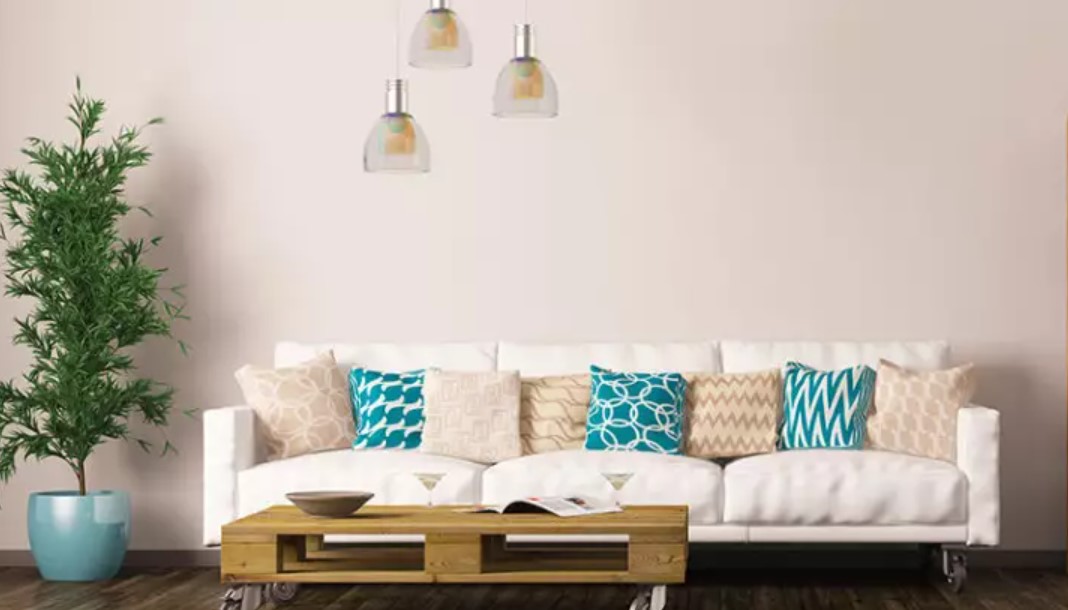Neutral paint colors form the foundation of interior design, offering versatility and timeless appeal to any space. Whether you prefer the crispness of classic white, the warmth of soft beige, or the sophistication of taupe, neutrals create a canvas that complements various styles and décor preferences. Explore the subtle nuances and transformative power of these essential hues.
The Neutral Paint Colors
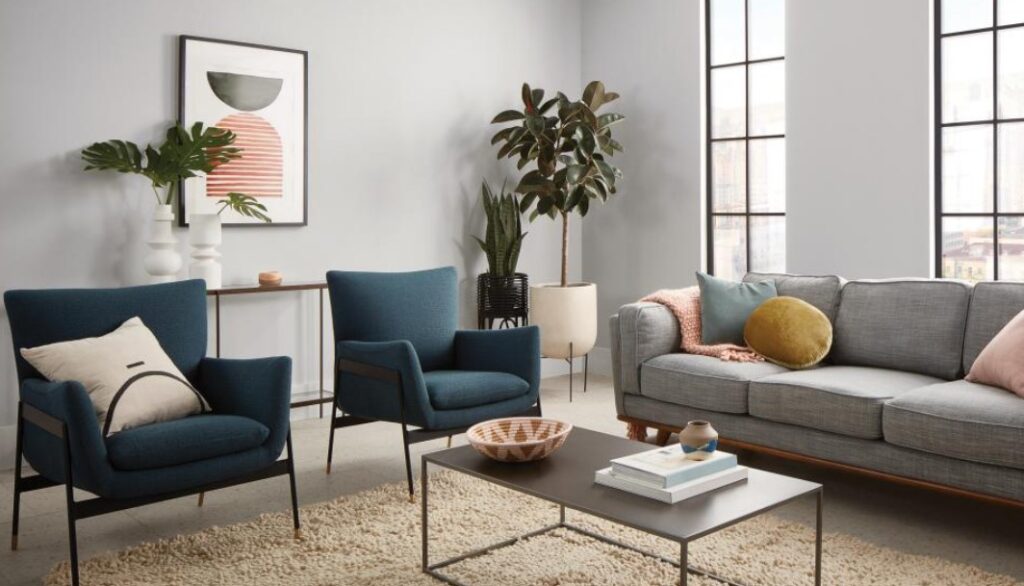
Classic White
Timeless Appeal and Versatility
Classic white paint transcends trends, making it a perennial favorite for interior walls. Its clean and bright appearance opens up spaces, reflects light, and serves as a backdrop for showcasing artwork and furnishings.
Different Shades and Their Effects
- Pure White: Creates a modern, minimalist look.
- Off-White: Adds warmth without overpowering small spaces.
- Antique White: Offers a vintage feel, ideal for traditional interiors.
Soft Beige
Warmth and Subtlety
Soft beige tones impart a cozy and inviting atmosphere, making them suitable for living rooms, bedrooms, and hallways. These hues blend effortlessly with both warm and cool color palettes.
Ideal Spaces for Soft Beige
Use soft beige in rooms with abundant natural light to enhance its warm undertones. Pair with rich wood accents and textured fabrics for a layered, tactile feel.
Gray Tones
Contemporary Elegance
Gray paint colors range from cool to warm tones, offering sophistication and versatility. They complement modern furnishings and architectural elements while providing a serene backdrop.
Choosing the Right Gray for Your Space
Consider the room’s orientation and natural light levels when selecting a gray shade. Light grays amplify space, while darker hues create intimacy and depth.
Greige
Blend of Gray and Beige
Greige combines the warmth of beige with the versatility of gray, making it a popular choice for contemporary interiors. It adapts seamlessly to changing light throughout the day.
Why Greige is Popular
Greige harmonizes with various décor styles and allows for easy pairing with accent colors. Its neutral nature makes it a safe yet stylish choice for walls and trim.
Taupe
Sophistication and Versatility
Taupe paint colors exude elegance and sophistication, bridging the gap between warm browns and cool grays. They provide a neutral backdrop that enhances architectural details.
Complementary Colors and Décor
Pair taupe with jewel-toned accents like deep greens or blues for a luxurious look. Incorporate metallic finishes in hardware and accessories to add depth and shine.
Creamy Whites
Soft and Inviting
Creamy white tones evoke a sense of tranquility and warmth, making them ideal for creating a cozy atmosphere in bedrooms and reading nooks. They reflect natural light beautifully.
Creating a Cozy Atmosphere
Layer creamy whites with soft textiles and plush furnishings to enhance their inviting nature. Consider using eggshell or satin finishes for added depth and durability.
Warm Browns
Earthy Tones and Richness
Warm brown paint colors bring a sense of earthiness and richness to interiors, grounding the space and adding depth. They create a comforting ambiance reminiscent of natural landscapes.
Enhancing Natural Light
Opt for warm browns in rooms with ample sunlight to highlight their natural undertones. Contrast with crisp white trim to maintain a balanced and harmonious look.
Pale Gray
Serene and Calming
Pale gray tones promote a sense of serenity and tranquility, making them suitable for bedrooms and spa-like bathrooms. They create a soothing backdrop that encourages relaxation.
Suitable Applications for Pale Gray
Use pale gray on walls in rooms with minimal natural light to brighten the space without overwhelming it. Pair with soft blues or greens for a refreshing contrast.
Muted Blues
Tranquility and Depth
Muted blue hues, such as slate or periwinkle, can function as neutrals in interior design. They offer a serene backdrop that promotes relaxation and creativity.
Using Blue as a Neutral
Incorporate muted blues in spaces where a calming atmosphere is desired, such as home offices or reading corners. Balance with warm wood tones and natural textures.
Greenish Grays
Subtle Hints of Green
Greenish grays blend the tranquility of gray with subtle green undertones, adding a touch of nature indoors. They create a refreshing and harmonious environment in living areas.
Incorporating Greenish Grays in Design
Use greenish grays in rooms that connect with outdoor spaces or feature large windows. Combine with botanical prints and indoor plants for a seamless transition to nature.
Choosing the Right Finish
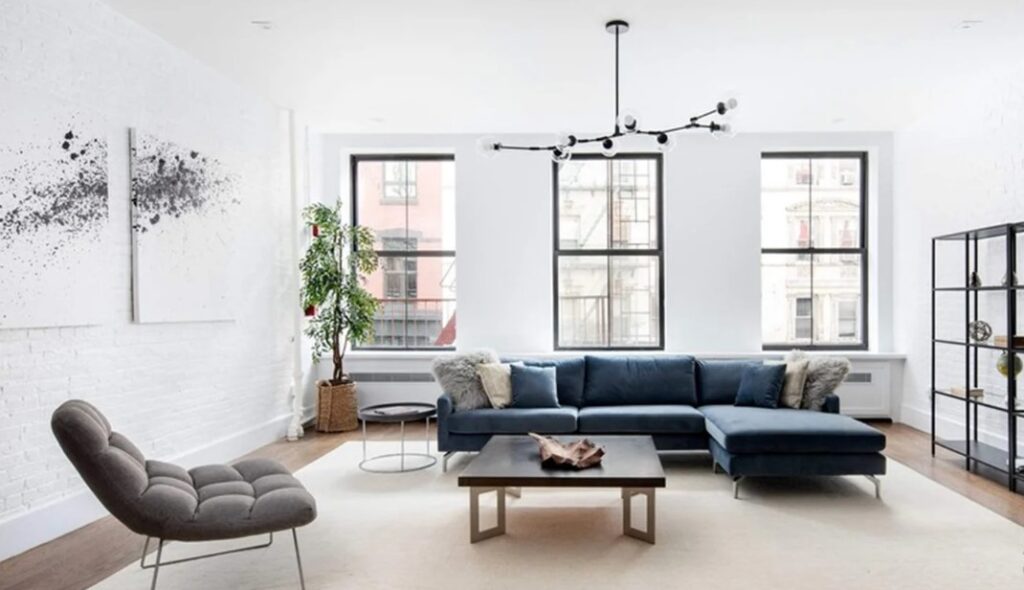
Matte vs. Satin vs. Glossy
Selecting the right paint finish is as crucial as choosing the perfect color for your space. The finish affects the paint’s appearance, durability, and how it interacts with light. This guide will help you understand the differences between matte, satin, and glossy finishes, so you can make an informed decision for your next painting project.
Matte Finish
Characteristics of Matte Finish
Matte finish paint has a non-reflective surface that provides a smooth and velvety appearance. It absorbs light rather than reflecting it, resulting in a rich, deep color.
Pros of Matte Finish
- Hides Imperfections: The lack of sheen minimizes the visibility of surface imperfections.
- Elegant Look: Provides a sophisticated, contemporary aesthetic.
- Touch-Up Friendly: Easy to touch up without noticeable differences in texture or color.
Cons of Matte Finish
- Less Durable: More prone to scuffs, marks, and stains, making it less suitable for high-traffic areas.
- Harder to Clean: Cleaning matte surfaces can be challenging, as vigorous scrubbing may damage the paint.
Ideal Rooms and Surfaces for Matte Finish
Matte finishes are perfect for:
- Bedrooms and living rooms where elegance is desired.
- Ceilings, as they reflect less light and hide imperfections.
- Low-traffic areas that do not require frequent cleaning.
Satin Finish
Characteristics of Satin Finish
Satin finish offers a soft, subtle sheen that lies between matte and glossy finishes. It reflects a small amount of light, giving surfaces a gentle glow.
Pros of Satin Finish
- Durability: More resistant to wear and tear compared to matte finishes.
- Easy to Clean: Can be wiped down without damaging the surface, making it suitable for busy areas.
- Versatile Look: Provides a balance between elegant and functional, fitting various styles.
Cons of Satin Finish
- Shows Imperfections: The slight sheen can highlight surface flaws and application marks.
- Variable Appearance: The finish can appear differently under various lighting conditions, which may affect color perception.
Ideal Rooms and Surfaces for Satin Finish
Satin finishes work well in:
- High-traffic areas like hallways and children’s rooms.
- Kitchens and bathrooms where moisture resistance is important.
- Trim, doors, and moldings for a cohesive, polished look.
Glossy Finish
Characteristics of Glossy Finish
Glossy finish paint is highly reflective, providing a shiny, mirror-like surface. It amplifies light and can make colors appear more vibrant.
Pros of Glossy Finish
- Maximum Durability: Highly resistant to scratches, stains, and moisture.
- Easy to Clean: Surfaces can be easily wiped clean, ideal for kitchens and bathrooms.
- Enhanced Aesthetics: Creates a dramatic effect, making architectural details stand out.
Cons of Glossy Finish
- Highlights Imperfections: Every flaw and brushstroke is magnified due to the high reflectivity.
- Preparation Intensive: Requires thorough surface preparation to achieve a smooth finish.
Ideal Rooms and Surfaces for Glossy Finish
Glossy finishes are best for:
- High-moisture areas like kitchens and bathrooms.
- Accent walls or trim to create focal points.
- Furniture and cabinetry for a modern, sleek look.
Comparing the Finishes
Durability and Maintenance
- Matte: Least durable, harder to clean, best for low-traffic areas.
- Satin: Moderately durable, easy to clean, suitable for most areas.
- Glossy: Most durable, easiest to clean, ideal for high-traffic and moisture-prone areas.
Aesthetic Appeal and Ambiance
- Matte: Offers a calm, understated elegance.
- Satin: Provides a soft, inviting glow.
- Glossy: Delivers a bold, high-impact look.
Practical Considerations for Different Spaces
- Use matte finishes for areas where a sophisticated, smooth look is desired without the need for frequent cleaning.
- Opt for satin finishes in versatile spaces that balance durability with aesthetics.
- Choose glossy finishes for surfaces that require frequent cleaning and a standout appearance.
Choosing the Right Finish for Your Home
Factors to Consider When Choosing a Finish
- Room Function: Consider how the room is used and the level of traffic it receives.
- Lighting: Assess natural and artificial lighting to determine how the finish will interact with light.
- Surface Condition: Evaluate the condition of the walls and how much preparation is needed.
Tips for Testing Finishes
- Sample First: Apply test samples in different areas of the room to observe the finish under various lighting conditions.
- Consider Sheen Levels: Remember that the same color can look different with varying levels of sheen.
Expert Recommendations for Common Areas
- Bedrooms and Living Rooms: Matte or satin for a relaxed, comfortable feel.
- Kitchens and Bathrooms: Satin or glossy for durability and ease of cleaning.
- Trim and Doors: Satin or glossy to highlight architectural details and provide durability.
Choosing the right paint finish can significantly impact the look and feel of your space. Whether you opt for the sophisticated elegance of matte, the versatile functionality of satin, or the bold statement of glossy, each finish offers unique benefits suited to different needs. Experiment with samples, consider your room’s specific requirements, and enjoy the process of finding the perfect finish for your home.
Considerations for Different Rooms
Choose matte finishes for bedrooms and living rooms to create a cozy atmosphere. Opt for satin or glossy finishes in kitchens and bathrooms for easy maintenance and durability.
Accent Colors
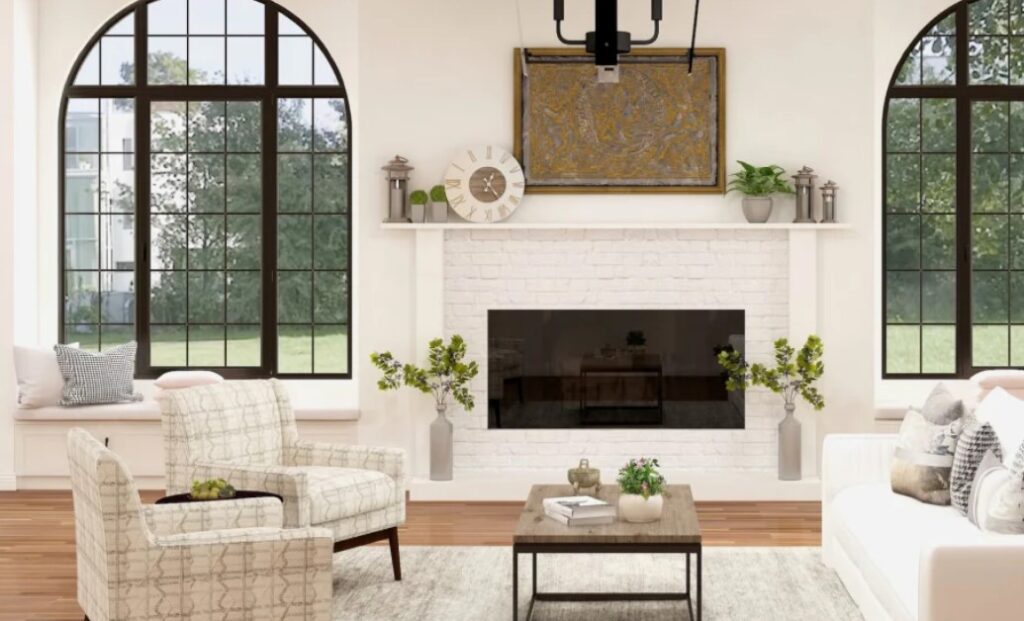
Accent neutral colors play a crucial role in interior design, offering a way to add depth and interest to your home without overwhelming your space. These subtle hues complement primary neutrals, providing a sophisticated and versatile palette that can transform any room. Let’s explore the world of accent neutral colors and how they can elevate your home’s aesthetic.
Understanding Accent Neutrals
Definition and Characteristics
Accent neutral colors are those that, while still neutral, have enough depth and richness to stand out against primary neutral shades like white, beige, and gray. They add visual interest and contrast, enhancing the overall design without clashing.
Difference Between Primary Neutrals and Accent Neutrals
Primary neutrals serve as the base colors in a room, offering a blank canvas for design. Accent neutrals, on the other hand, provide focal points and highlights, creating depth and dimension. While primary neutrals are typically lighter and more understated, accent neutrals are richer and more dynamic.
Popular Accent Neutral Colors
Charcoal Gray
Charcoal gray is a deep, rich color that adds sophistication and elegance to any space. It’s versatile enough to work with various color schemes and can make a bold statement without being too overpowering.
Navy Blue
Navy blue offers depth and richness, creating a striking contrast when paired with lighter neutrals. It’s perfect for adding a touch of classic elegance and can be used in both modern and traditional settings.
Olive Green
Olive green brings an earthy, calming vibe to interiors. It’s a great choice for adding warmth and can be easily paired with other neutrals to create a harmonious, nature-inspired look.
Soft Black
Soft black is a modern, dramatic choice that can add a sophisticated edge to your design. It’s less harsh than pure black, making it more versatile and easier to incorporate into various spaces.
Blush Pink
Blush pink offers a subtle, sophisticated touch of color. It’s perfect for creating a gentle, inviting atmosphere and pairs beautifully with both warm and cool neutrals.
Charcoal Gray
Versatility and Elegance
Charcoal gray works well in various settings, from contemporary to classic. Its deep tone provides a grounding effect, making it a perfect choice for accent walls, furniture, and accessories.
Best Spaces to Use Charcoal Gray
- Living Rooms: Create a focal point with a charcoal gray accent wall.
- Bedrooms: Add depth with charcoal gray bedding or curtains.
- Home Offices: Enhance productivity with a sophisticated charcoal gray desk or shelving.
Navy Blue
Depth and Richness
Navy blue brings a timeless elegance to interiors. Its depth makes it an excellent choice for creating a cozy, intimate atmosphere, especially in larger rooms.
Creating Contrast with Navy Blue
- Pair with Whites: For a classic, crisp look.
- Combine with Metallics: To add a touch of glamour.
- Use in Textiles: Such as rugs and throw pillows for subtle accents.
Olive Green
Earthy and Calming
Olive green is perfect for creating a serene, nature-inspired ambiance. Its earthy tones blend well with wood and other natural materials.
Pairing Olive Green with Other Neutrals
- Beige and Cream: For a soft, harmonious palette.
- Gray and White: To balance warmth with coolness.
- Terracotta and Brown: For a rich, grounded look.
Soft Black
Modern and Dramatic
Soft black can add a modern, sophisticated touch to any room. It’s less intense than true black, making it easier to work with while still providing a striking visual impact.
Using Soft Black in Different Rooms
- Kitchens: For cabinets or an accent wall.
- Bathrooms: In fixtures or tile work.
- Living Spaces: On furniture pieces like coffee tables or bookshelves.
Blush Pink
Subtle and Sophisticated
Blush pink adds a soft, romantic touch to interiors. It’s versatile enough to be used in various ways, from wall colors to accent pieces.
Incorporating Blush Pink in Décor
- Textiles: Use blush pink in cushions, throws, or curtains.
- Artwork: Incorporate blush pink tones in wall art.
- Furniture: Add a blush pink armchair or ottoman for a pop of color.
Pairing Accent Neutrals with Primary Neutrals
Creating Harmonious Color Schemes
Balance is key when pairing accent neutrals with primary neutrals. Use accent colors sparingly to avoid overwhelming the space. Consider the undertones of your primary neutrals to ensure a cohesive look.
Tips for Balancing Colors
- Rule of Three: Stick to three main colors in a room – a primary neutral, an accent neutral, and one additional color.
- Even Distribution: Spread accent colors evenly throughout the room to create a balanced look.
- Layering Textures: Use different textures to add depth and interest without relying solely on color.
Accent Neutrals in Different Spaces
Living Room
- Charcoal Gray Accent Wall: Creates a focal point and adds sophistication.
- Navy Blue Sofas: Provide a rich, cozy seating option.
- Olive Green Plants: Add a touch of nature and warmth.
Bedroom
- Blush Pink Bedding: Adds a soft, inviting touch.
- Soft Black Furniture: Creates a modern, chic look.
- Navy Blue Curtains: Offer depth and a sense of luxury.
Kitchen
- Olive Green Cabinets: Bring warmth and a nature-inspired feel.
- Charcoal Gray Backsplash: Adds elegance and contrast.
- Soft Black Appliances: Provide a sleek, modern touch.
Bathroom
- Navy Blue Towels: Add a rich, luxurious feel.
- Blush Pink Accessories: Create a subtle, sophisticated touch.
- Charcoal Gray Vanity: Provides a stylish focal point.
Home Office
- Soft Black Desk: Adds a modern, professional look.
- Olive Green Wall Art: Brings a calming, nature-inspired vibe.
- Navy Blue Shelving: Offers depth and a sense of order.
Textures and Patterns
Adding Dimension with Textures
Incorporate various textures such as woven fabrics, plush rugs, and natural materials to add depth to your design. Textures can enhance the richness of accent neutral colors.
Using Patterns to Complement Accent Neutrals
Patterns like stripes, florals, and geometrics can add visual interest. Choose patterns that incorporate your accent neutral colors to create a cohesive look.
Lighting Considerations
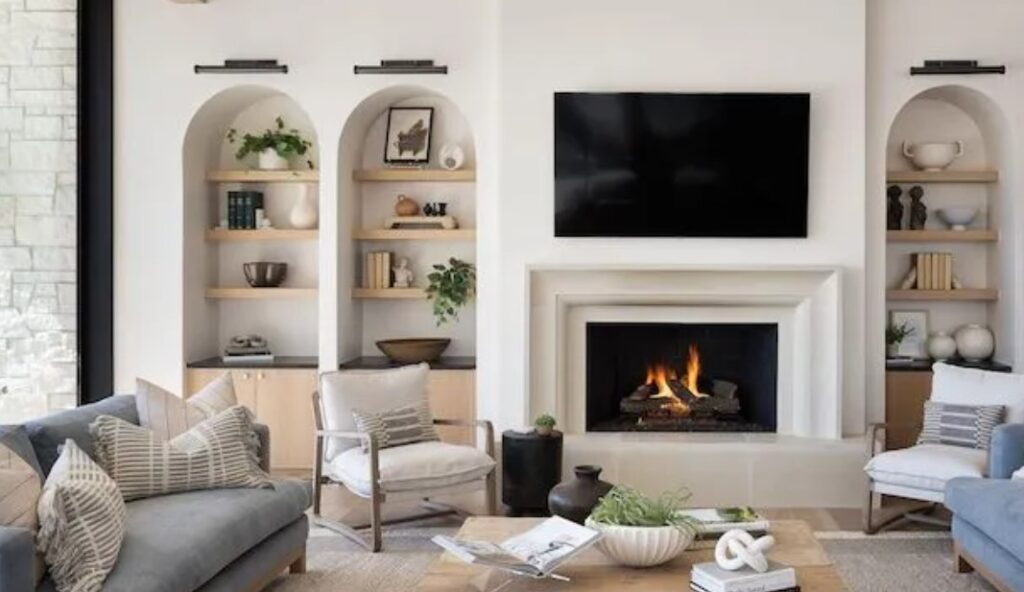
Impact of Lighting on Accent Neutrals
Natural light can enhance the true tones of your accent neutrals, while artificial light can alter their appearance. Test your colors under different lighting conditions to ensure they achieve the desired effect.
Adjusting Colors Based on Natural and Artificial Light
- Warm Lighting: Can make cool tones appear warmer.
- Cool Lighting: Can enhance the crispness of warm tones.
- Layered Lighting: Use a mix of lighting sources to create a balanced look.
Neutral paint colors offer endless possibilities for creating inviting and harmonious interiors. Whether you prefer the understated elegance of soft beige, the contemporary appeal of gray tones, or the timeless versatility of classic white, neutrals provide a backdrop that enhances any décor style. Embrace the subtleties of these essential hues to transform your living spaces with warmth, sophistication, and enduring style.
